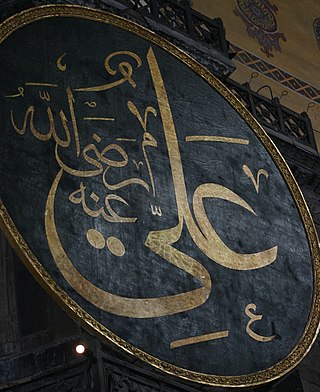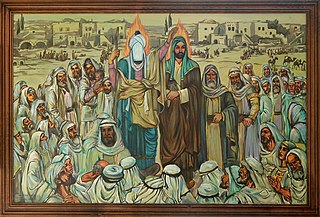
Abd Allah ibn Abi Quhafa, commonly known by his kunyaAbu Bakr, was the first caliph, ruling from 632 until his death in 634. As a senior companion of Muhammad and, through his daughter Aisha, also his father-in-law, Abu Bakr is referred to with the honorific title al-Siddiq by Sunni Muslims.

Ali ibn Abi Talib was the cousin and son-in-law of the Islamic prophet Muhammad, and was the fourth Rashidun caliph who ruled from 656 to 661, as well as the first Shia imam. Born to Abu Talib ibn Abd al-Muttalib and Fatima bint Asad, a young Ali was raised by his elder cousin Muhammad and was among the first to accept his teachings.

Zaydism is one of the three main branches of Shia Islam that emerged in the eighth century following Zayd ibn Ali‘s unsuccessful rebellion against the Umayyad Caliphate. Zaydism is typically considered to be a branch of Shia Islam that comes closest to the Sunni, although the "classical" form of Zaydism over the centuries had changed its posture with regard to Sunni and Shia traditions multiple times, to the point where interpretation of Zaydi as Shia is often based on just their acceptance of Ali as a rightful successor to Muhammad. Zaydis regard rationalism as more important than Quranic literalism and in the past were quite tolerant towards Sunni Shafiism, a religion of about half of the Yemenis.
Banu Abd Shams refers to a clan within the Meccan tribe of Quraysh.
The Saqifa of the Banu Sa'ida clan refers to the location of an event in early Islam where some of the companions of the Islamic prophet Muhammad pledged their allegiance to Abu Bakr as the first caliph and successor to Muhammad shortly after his death in 11 AH. The Saqifa meeting is among the most controversial events in early Islam, due to the exclusion of a large number of Muhammad's companions, including his immediate family and notably Ali, his cousin and son-in-law. The conflicts that arose soon after Muhammad's death are considered to be the main cause of the current division among Muslims. Those who accepted Abu Bakr's caliphate were later labeled Sunnis, while the supporters of Ali's right to caliphate were later labeled Shia.

The Election of Uthman refers to the appointment of Uthman ibn Affan as the third caliph by a committee, which was assembled by the dying caliph Umar in 23 AH. The committee likely consisted of six early Muslims from the Quraysh tribe, including the prophet Muhammad's second cousin and son-in-law Uthman and Muhammad's first cousin and son-in-law Ali ibn Abi Talib. The deciding vote was given to Uthman's brother-in-law Abd al-Rahman ibn Awf, who appointed the former as the next caliph after the deliberations stalled. The choice of the wealthy Uthman is often explained as intended to guard the interests of the Quraysh and to follow the practices of the first two caliphs, namely, Abu Bakr and Umar. The committee has been criticized for its bias towards Uthman and for its exclusion of the Ansar.
The issue of succession following the death of the Islamic prophet Muhammad is the central issue in the schisms that divided the early Muslim community in the first century of Islamic history into numerous schools and branches. The two most prominent branches that emerged from these divisions are Sunni and Shia branches of Islam. Sunni Islam asserts that Abu Bakr rightfully succeeded Muhammad through a process of election. In contrast, Shia Islam maintains that Ali ibn Abi Talib was Muhammad's designated successor.
Abu Dharr Al-Ghifari Al-Kinani, also spelled Abu Tharr or Abu Zar, born Jundab ibn Junādah, was the fourth or fifth person converting to Islam, and a member of the Muhajirun. He belonged to the Banu Ghifar, the Kinanah tribe. His date of birth is unknown. He died in 652 CE, at Al-Rabadha, in the desert east of Medina.
Rafida broadly refers to those Shia Muslims who 'reject' the legitimacy of the caliphates of Abu Bakr, Umar, and Uthman, in favor of Ali ibn Abi Talib, the cousin and son-in-law of the Islamic prophet Muhammad. Rooted in early Islamic history, the term Rafida is used in Sunni polemics against Shi'ism. Several Shia scholars view the term in a favourable light to signify Shias' rejection of those they regard as oppressive Sunni rulers.

Ali ibn Abi Talib was the cousin and son-in-law of the Islamic prophet Muhammad. Ali contributed significantly to Islam in its early years and was likely the first male to accept the teachings of Muhammad. Ali is accorded an almost legendary place in Islam as a paragon of virtues, a fount of wisdom, and a fearless but magnanimous warrior. In Shia Islam Ali is regarded as the foremost companion of Muhammad and his rightful successor through divinely-ordained designation at the Ghadir Khumm.

The Ghadīr Khumm was a gathering of Muslims to attend a sermon delivered by the Islamic prophet Muhammad on 16 March 632 CE. The gathering is said to have taken place by the ghadir (pool) in the wadi of Khumm, located near the then settlement of al-Juhfa on the path between Mecca and Medina, where Muhammad halted the large caravan of Muslims who had accompanied him in the Farewell Pilgrimage, his only Hajj ritual.

Ali ibn Abi Talib is recognized as the fourth Sunni caliph and the first Shia imam. Shia and some Sunni sources introduce Ali as the only person born inside the Ka'ba, the ancient shrine in the city of Mecca which later became the most sacred site in Islam.

Ali ibn Abi Talib was the cousin and son-in-law of the Islamic prophet Muhammad. Ali contributed significantly to Islam in its early years and was likely the first male to accept the teachings of Muhammad. In Sunni Islam, Ali is recognized as a close companion, a foremost authority on the Quran and Islamic law, and the fountainhead of wisdom in Sunni spirituality. When Muhammad died in 632 CE, Ali had his own claims to leadership, perhaps in reference to Muhammad's announcement at the Ghadir Khumm, but he eventually accepted the temporal rule of the first three caliphs in the interest of Muslim unity. During this period, Ali is portrayed in Sunni sources as a trusted advisor of the first three caliphs, while their conflicts with Ali are neutralized or downplayed. Ali himself succeeded to the caliphate in 656 but his rule was immediately challenged by multiple pretenders and he was assassinated in 661.

The Shaqshaqiya sermon is a controversial text in Nahj al-balagha, the best-known collection of sermons, letters, and sayings attributed to Ali ibn Abi Talib, who was the fourth Rashidun caliph, the first Shia imam, and the cousin and son-in-law of the Islamic prophet Muhammad. The sermon is highly critical of the predecessors of Ali, namely, Abu Bakr, Umar, and Uthman, accusing them of usurping the right of Ali to the caliphate.
The Muhajirun were the converts to Islam and the Islamic prophet Muhammad's advisors and relatives, who emigrated from Mecca to Medina, the event is known in Islam as the Hijra. The early Muslims from Medina are called the Ansar ("helpers").
Muhammad, the final Islamic prophet, was born and lived in Mecca for the first 53 years of his life until the Hijra. This period of his life is characterized by his proclamation of prophethood. Muhammad's father, Abdullah ibn Abd al-Muttalib, died before he was born. His mother would raise him until he was six years old, before her death around 577 CE at Abwa'. Subsequently raised by his grandfather, Abd al-Muttalib, and then his uncle, Abu Talib ibn ‘Abd al-Muttalib, Muhammad's early career involved being a shepherd and merchant. Muhammad married Khadija bint Khuwaylid after a successful trading endeavour in Syria. After the death of Khadija and Abu Talib in the Year of Sorrow, Muhammad married Sawda bint Zam'a and Aisha.

The attack on Fatima's house refers to a disputed violent attack on the house of Fatima, daughter of the Islamic prophet Muhammad. The attack is said to have taken place shortly after the death of Muhammad in 11 AH and was instigated by his successor Abu Bakr and led by Umar, another companion. The purpose of the attack was to arrest Fatima's husband Ali, who had withheld his pledge of allegiance to Abu Bakr. Her injuries during the raid might have caused the young Fatima's miscarriage and death within six months of Muhammad.
Sakhr ibn Harb ibn Umayya, commonly known by his kunyaAbu Sufyan, was a prominent opponent-turned companion and father-in-law of the Islamic prophet Muhammad. He was the father of the first Umayyad caliph Mu'awiya I and namesake of the Sufyanid line of Umayyad caliphs which ruled from 661 to 684.
Laylat al-mabit refers to the night in 622 CE in which the Islamic prophet Muhammad fled Mecca for Yathrib, apparently to foil an assassination plan. His escape from Mecca followed the exodus of his persecuted followers to the safe haven of Yathrib, a city that was later renamed Medina in his honor. Laylat al-mabit is often associated in Islamic literature with the reports that Muhammad's cousin Ali ibn Abi Talib risked his life to facilitate Muhammad's safe escape from Mecca.

Ali ibn Abi Talib was acclaimed in 656 CE as the fourth caliph after the death of the Islamic prophet Muhammad. Following the 656 assassination of the third caliph Uthman in Medina by provincial rebels who had grievances about injustice and corruption, the prophet's cousin and son-in-law was elected to the caliphate by the rebels, the Ansar, and the Muhajirun. While the election of Ali faced little opposition, his support was limited among the Quraysh, some of whom aspired to the caliphate. The Umayyads and some others thereby left Medina––some thus breaking their oaths of allegiance––and soon rebelled against Ali.










